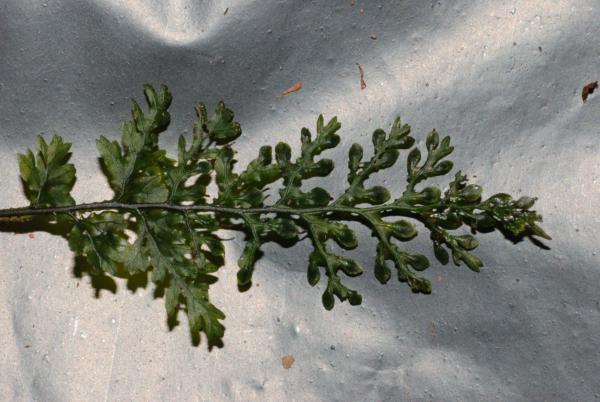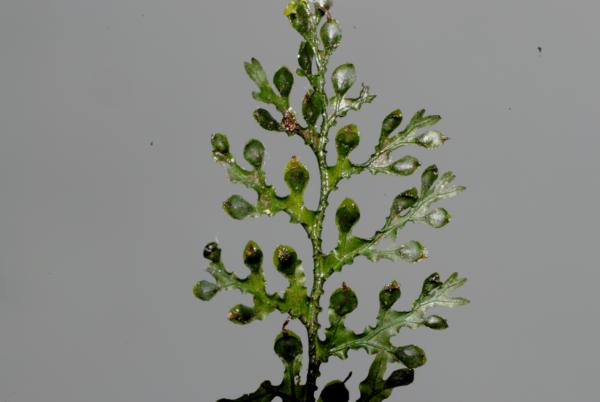
Crepidomanes latealatum (Bosch) Copel.
Family
Hymenophyllaceae
Nomenclature
Crepidomanes latealatum (Bosch) Copel., Philipp. J. Sci. 67: 60. 1938; Ching, Fl. Reipubl. Popularis Sin. 2: 165. 1959; Tagawa & K.Iwats., SouthE. Asian Stud. 5:42. 1967; Tagawa & K.Iwats., Fl. Thailand 3: 89. 1979; Tagawa & K.Iwats., Fl. Thailand 3: 613. 1989; Boonkerd & Pollawatn, Pterid. Thailand: 70. 2000. – Didymoglossum latealatum Bosch, Ned. Kruidk. Arch. 5(3): 138. 1863; Copel., Philipp. J. Sci. 51: 192, pl. 25–26. 1933. – Trichomanes bipunctatum var. latealatum (Bosch) C.B.Clarke, Trans. Linn. Soc. London Bot. ser. 2, 1: 49. 1880; C.Chr., Contr. U.S. Natl. Herb. 26: 330. 1931. – Trichomanes latealatum (Bosch) Christ, Verh. Naturf. Ges. Basel 11: 424. 1896; Tardieu & C.Chr., Fl. Indo-Chine 7(2): 64. 1939; Holttum, Rev. Fl. Malaya ed. 1, 2: 101. 1955 [‘1954’]; Holttum, Dansk Bot. Ark. 20: 17. 1961; Newman et al., Checkl. Vasc. Pl. Lao PDR: 27. 2007.
Didymoglossum plicatum Bosch, Ned. Kruidk. Arch. 5: 139. 1863. – Trichomanes plicatum (Bosch) Bedd., Ferns Brit. India: t. 285. 1868; Tardieu & C.Chr., Fl. Indo-Chine 7(2): 65. 1939; Holttum, Dansk Bot. Ark. 23: 229. 1965; Sledge, J. Linn. Soc. Bot. 60: 305. 1968. – Trichomanes bipunctatum var. plicatum (Bosch) Bedd., Handb. Ferns Brit. India: 42. 1883.
Didymoglossum insigne Bosch, Ned. Kruidk. Arch. 5: 143. 1863. – Trichomanes insigne Bedd., Ferns Brit. Ind.: t. 284. 1868; Tardieu & C.Chr., Fl. Indo-Chine 7(2): 64. 1939. – Crepidomanes insigne (Bosch) Fu, Ill. Handb. Chin. Pl. Pterid.: 39. 1957
Description
Rhizome <1 mm diam., covered with dark brownish hairs. Stipes 0.6–2.8 cm long, winged almost to the base, bearing short hairs. Laminae variable in shape and size, ovate to oblong, round to acute at apex, bipinnatifid, 3–10 cm long, 1.2–3 cm wide, often dwarfed with sori; first or second pinnae longest, 1.2–1.8 by 0.5–0.6 cm; ultimate segments linear-lanceolate, at a narrow angle to each other, acute at apex, entire and flat at margin; no false veinlets, the other striae numerous. Sori on the apices of short axillary lobes; involucre tubular, 1–1.8 mm long, winged, the mouth bilabiate, the lips round to acute , as wide as long.
Distribution in Thailand
NORTHERN: Mae Hong Son, Chiang Mai, Chiang Rai, Tak, Phitsanulok; NORTH-EASTERN: Loei; SOUTH-WESTERN: Kanchanaburi, Phetchaburi, Prachuap Khiri Khan; CENTRAL: Nakhon Nayok; SOUTH EASTERN; Chanthaburi; PENINSULAR: Nakhon Si Thammarat, Trang.
Distribution in Laos
Champasak, Khammouane.
Wider Distribution
N India, S China and in SE Asia.
Ecology
On mossy tree trunks or on mossy or muddy rocks in moist dense forest, common at various altitudes.
Proposed IUCN Conservation Assessment
Least Concern (LC). This species is widespread and not under any immediate known threat.
Voucher specimens - Thailand
Middleton et al. 4478, Chiang Mai, Doi Suthep-Doi Pui National Park (E); Middleton et al. 4901, Chiang Mai, Doi Inthanon National Park (E).
Frond
Frond showing sori in involucres
Site hosted by the Royal Botanic Garden Edinburgh. Content managed by Stuart Lindsay, Gardens by the Bay, Singapore and David Middleton, Singapore Botanic Gardens. Last updated 24 January 2012

